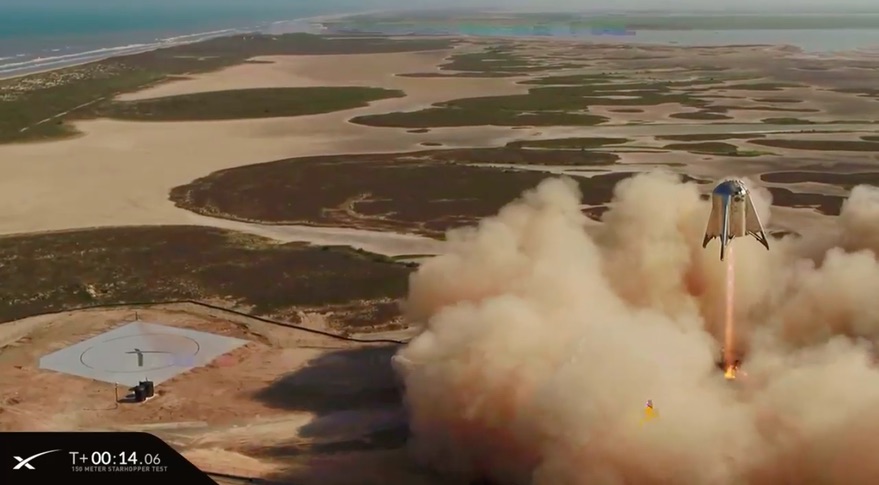

|
Starhopper completes test flight
 [SN] WASHINGTON — A prototype of SpaceX’s next-generation launch system performed a brief test flight Aug. 27, a key step in the system’s development. [SN] WASHINGTON — A prototype of SpaceX’s next-generation launch system performed a brief test flight Aug. 27, a key step in the system’s development.The “Starhopper” vehicle lifted off from a pad at SpaceX’s test site near Brownsville, Texas, at 6:02 p.m. Eastern. The vehicle took off vertically, translated a short distance, then landed vertically on a different pad a little less than a minute after takeoff. The long-awaited test was intended to go to an altitude of 150 meters, although it was not immediately clear from the webcast of the flight exactly what altitude the vehicle achieved. The company provided no commentary for the webcast, and ended it shortly after the vehicle made what appeared to be a successful landing. SpaceX attempted to fly Starhopper Aug. 26, but the attempt was scrubbed after the Raptor engine failed to ignite. SpaceX Chief Executive Elon Musk later tweeted that “dual redundant torch igniters” in the engine appeared to have malfunctioned and needed to be inspected before trying again. The vehicle, powered by a single Raptor engine that uses methane and liquid oxygen propellants, made its first free flight July 25, rising several meters off the pad before landing about 10 to 15 seconds later. At the time, Musk said he expected a “hop” to an altitude of 200 meters in “a week or two.” This flight, though, was delayed by issues amending the company’s experimental permit issued by the Federal Aviation Administration’s Office of Commercial Space Transportation. “Need a bit more hazard analysis & should be clear to fly soon,” Musk tweeted Aug. 15. That revised permit was issued by the FAA Aug. 23, but limited SpaceX to a single flight of the vehicle to 150 meters altitude. The permit also increased the third-party liability insurance requirement from $3 million to $100 million, reflecting the apparently greater potential damage the vehicle could do in the event of an accident. SpaceX’s South Texas site is unusual in that people live within a few kilometers of what the company eventually plans to be an orbital spaceport, in a subdivision called Boca Chica Village that predates the site by decades. Residents of the subdivision reported on social media that they were informed by local law enforcement to stand outside of their homes during the test, in the event an explosion created a shock wave that could break windows. While the flight appeared to be a success, SpaceX has no plans to fly Starhopper again. Musk has stated that the company will instead press ahead to flights of prototypes of Starship, designed ultimately to be the reusable upper stage flown on top of a large booster called Super Heavy. Starship, though, will be able to fly on its own and even make orbit, the company says. Two Starship prototypes are currently under construction, one at the South Texas site and the other at an industrial site in Cocoa, Florida. The Florida version of Starship will be taken by truck and barge to Cape Canaveral for test flights. Musk had planned to give an update on development of Starship and Super Heavy Aug. 24 at the South Texas site, but he delayed it several days before the event, saying it would be better to hold the event once the “Starship Mark 1” vehicle at the site had three Raptor engines installed, along with other components. Musk estimated that to be completed in mid-September. Starhopper will now be used as a vertical test stand for Raptor engine tests. “It’s quite robust,” Musk said of the vehicle’s design in an Aug. 25 tweet. Posted by: 3dc 2019-08-28 |
| http://www.rantburg.com/poparticle.php?ID=549021 |